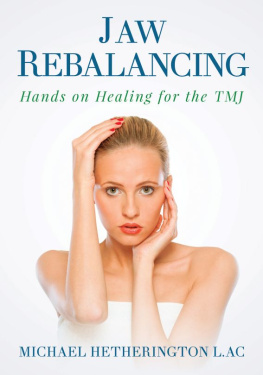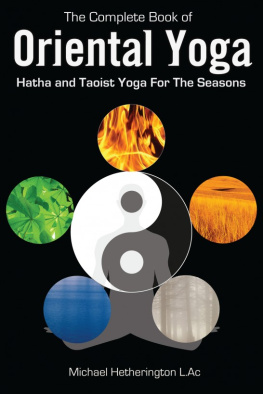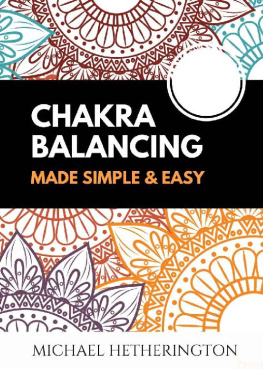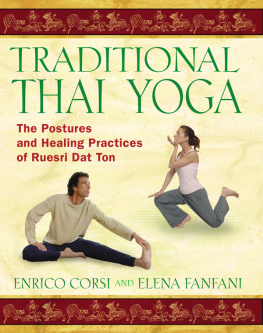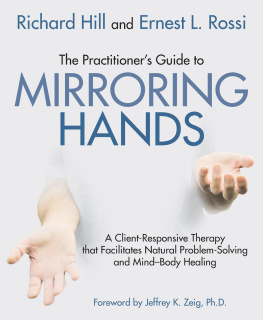Rebalancing the Jaw
Hands on Healing for the TMJ
Michael Hetherington
(L.Ac & Yoga Teacher)
~~~
Smashwords Edition
Copyright 2013 Michael Hetherington
By law, this work is protected by copyright.Therefore, no one is permitted to copy, broadcast, transmit, showor play in public, adapt or change in any way the content of thisbook - for any other purpose whatsoever - without prior writtenpermission from Michael Hetherington.
Australia
Smashwords Edition, License Notes
This ebook is licensed for your personalenjoyment only. This ebook may not be re-sold or given away toother people. If you would like to share this book with anotherperson, please purchase an additional copy for each recipient. Ifyoure reading this book and did not purchase it, or it was notpurchased for your use only, then please return to Smashwords.com and purchaseyour own copy. Thank you for respecting the hard work of thisauthor.
Disclaimer
All material in this book is provided foryour information only and may not be construed as medical advice orinstruction. No action or inaction should be taken based solely onthe contents of this information; instead, readers should consultthe appropriate health professionals on any matter relating totheir health and well-being.
The information and opinions expressed hereare believed to be accurate, based on the best judgment availableto the authors, and readers who fail to consult with theappropriate health authorities assume the risk of any injuries. Thepublisher is not responsible for errors or omissions.
About the Author
Michael Hetherington is a qualifiedacupuncturist, health practitioner and yoga teacher based inBrisbane, Australia. He has a keen interest in mind-body medicine,energetic anatomy, nutrition and herbs, yoga nidra and Buddhiststyle meditation. Inspired by the teachings of many he has learnedthat a light-hearted, joyful approach to life serves best.
www.michaelhetherington.com.au
Other Titles by Author:
Chakra Balancing Made Simple and Easy
How to Do Restorative Yoga
Autumn Oriental Yoga
Meditation Made Simple
The Little Book of Yin
How to Learn Acupuncture
Table of Contents
Introduction
The aim of this book is to explain andprovide a safe and effective healing method for rebalancing andhealing the jaw. The Jaw Rebalancing technique is designed as aone- on-one treatment protocol, meaning that a giver and a receiveare required to perform the treatment properly. It is possible togive the treatment to yourself, but it is not ideal simply becausethe arm and shoulder placements required will possibly aggravatethe condition, as it can often cause extra muscular tension in theshoulders.
The idea for this book came about over theprocess of the last five years as I continued to come into contactwith people, friends, family and patients from all over the worldwho expressed some kind of jaw problem and discomfort. In many ofthe cases, the cause was largely unknown. However, it seemed thatthe jaw problems were often triggered by stress, which is somethingwith which we will go into much greater detail later in thisbook.
When I trained in acupuncture and massagetherapy, we were given a protocol of treatment for jaw disorders,yet when I applied these protocols in a clinical setting, theresults werent as good as I was hoping. This then led me to lookfurther into how western medicine was approaching temporomandibularjoint (TMJ) disorders. What I discovered was that they have littleunderstanding as to its causes and also have limited success withtheir treatment protocols. This then spurred me on, over the nextfew years, to continue with my own self study of the jaw. What Idiscovered can be found within these pages. It is the combinationof an intention, creating the right conditions for healing tooccur, and using a series of hand placements in and around the jaw,the head and the neck area of the patient aimed at releasingmuscular tension and restoring natural placement of the jaw itself.I have also endeavored to include after treatment practices thatwill continue to heal and relax the jaw and muscles that areconnected to the TMJ.
80% of patients seek out a healthprofessional due to pain-related symptoms, therefore making painthe number one reason why people seek healthcare. In relation tojaw health and TMJ disorders, this is no different. As a result,pain will be the main reason people seek out treatment foraddressing their TMJ disorder. You may be reading this book as aresult of suffering from jaw pain yourself, or because someoneclose to you suffers from it. Another reason you may be readingthis book is because you too are in the health profession and areseeking new and more effective ways to treat TMJ disorders in yourclinic. Whatever your reason, this book is designed to help thosewith TMJ with a gentle treatment approach and to help equippractitioners with a new skill set when treating people who presentTMJ disorders.
It is my hope that this book will contributeto the treatment of TMJ disorders so that we can address thiscommon discomfort more effectively.
Lets get into it.
How to Read ThisBook
I would advise reading through the first partof the book in whole before practicing any of the practical aspectsof the Jaw Rebalancing technique. This is because the first part ofthe book is written in a way that prepares the practitioner to bein the right frame of mind for giving healing-focused treatments,and it also lays down the fundamental principles for treating theTMJ.
Once you have read through it, startpracticing the Jaw Rebalancing technique on a friend of familymember. Feel free to write your own notes or write down thesequence in your own words so that it becomes easier and morefree-flowing to practice. Be sure to keep the practice in the samesequence as outlined in this book because this sequence has beenfound, through ongoing clinical experience, to give the bestresults.
Basic TMJ Anatomy
The Tempromandibular joint (TMJ) comprises ofa complex joint system located where the lower jaw (mandible) meetsthe temporal bones of the skull. A joint is defined as a placewhere two bones meet. In most joints, including the TMJ, thereexists a dense, fibrous, gel-like cartilage tissue that acts tostop the bones making direct contact with each other while alsohelping to distribute the pressure more evenly throughout thejoint. This fibrous, gel-like tissue in the TMJ is called thearticular disc.
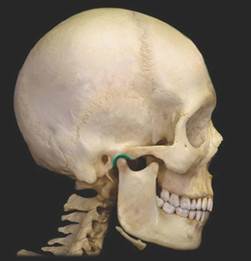
Image credit: www.studyblue.com
The TMJ is classified as both a hinge actionjoint as well as a sliding joint, which makes it a unique jointsystem in the human body. This complex joint system allows for themovements required for eating, swallowing, talking and yawning.
A number of ligaments attach to the bonesaround the joint structure to provide stability, and there are fourprimary muscles involved in the main movements of the jaw.
They are:
- The masseter
- The temporalis muscle
- The medial pterygoid
- The lateral pterygoid
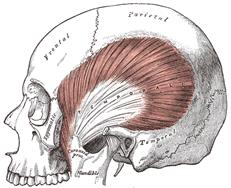
Image of the temporalis muscle
A number of other muscles and ligaments inthe face, neck and shoulders can also easily be involved andrecruited depending on the activity engaged in and the posturalalignment. This is why there is a connection between shoulder andneck muscular tension and TMJ disorders.
What is rarely mentioned in anatomy books andresources relating the TMJ is the connective tissue. Connectivetissue is like a plastic wrapper that encapsulates all organs,bones and joints throughout the body. Consider it like a type ofskin on the inside of the body. Connective tissue, when firstdiscovered, was thought to have little influence in overall bodilyphysiology, but now medical scientists are realizing that theconnective tissue plays an important role in a large number offunctions throughout the body. It has been found to be involved inthe storage of energy, the distribution of hormones, the protectionof organs and structures, the distribution of fluids, and theconnection of body tissues to name just a few. Therefore,connective tissue may also play a role in many TMJ disorders.

